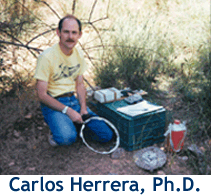Carlos M. Herrera (2004)
From an “Ecologist Directory” maintained by the ESA Education Office about 2004-2005. Profile circa 2004.
Degree Ph.D. 1977 (University of Sevilla)
Position Professor of Research
Department The Estacion Biologica de Doñana, Sevilla
Organization Research Institute of the Spanish CSIC (Consejo Superior de Investigaciones Cientificas)
ESA Honorary Membership Award for 2002

When did you become interested in ecology?
In retrospect, I think it was a consequence of my first contacts with people at the Estación Biológica de Doñana while I still was a biology student. It was a pleasant surprise to discover that, although admittedly tiny, there were some possibilities of making a living doing exactly what I liked most; that is, going out to the field, watching birds or any other living creature and then, back home, reading and thinking on what I had seen and jotting notes about that. Even at risk of sounding somewhat cynical, I must honestly say that I gave a try to a career in ecology as a way of transforming my preferred hobby into my job so as to have fun more days a week. I was lucky enough to succeed.
Describe your route to a career in (or using) ecology. What challenges did you need to overcome? What was your training, and what positions have you held?
Almost everything and everybody are, to a greater or lesser extent, influential on one’s life, and scientists are no exception to this. If I had to single out the few most influential persons on my career, I ought to start by mentioning my father, who frequently brought me – an urban child living in a mid-sized city of post civil war Spain – to the field and taught me the first plant and animal names when I was only 5. That was the spark that aroused my love for nature. Much later, while already a biology student at the University of Sevilla, I was deeply influenced by the interaction with Jose A. Valverde, the founder of Doñana National Park and first director of the Estación Biológica de Doñana, later to become my home institution during my whole career. Valverde quickly became the model to follow and taught me – through personal example, never by sermonising – that science is only worth its name from an attitude of permanent search and scrutiny, hard work and, above all, fierce intellectual independence. Other scientists who have influenced me strongly through their writings and ideas include Ramon Margalef and Robert MacArthur, who were my intellectual heroes during my twenties. In my early thirties, Daniel Janzen’s publications on tropical ecology sparked my early interest on plant-animal interactions and taught me the essential importance – and the immense personal pleasure, as I then discovered – of incorporating detailed, first-hand natural history observations and ‘ecological realism’ into evolutionary ecological research.
I studied at the University of Sevilla between 1970 and 1974, where I obtained a biology degree. During those years, I also frequented the Estación Biológica de Doñana, where I often joined graduate students in their field trips, helped as a voluntary worker, and spent countless hours dwelling at what then seemed to me the most wonderful library on Earth (actually, a very modest library). I obtained a “doctorado” (PhD degree) at the University of Sevilla in 1977, with a work on the bird communities of the oak woodlands in Sierra Morena, a mountain range in northern Andalusia. My doctoral advisor was Jose A. Valverde, but in those times the “sink or swim” strategy was so widespread that doctoral advisors generally gave little advice. My case probably was an extreme one, as my advisor saw my doctoral work only when I showed him the final-bound set of copies and asked for his mandatory signature. Afterwards, my training continued along a similarly autodidactic line. This was largely so out of necessity, but also perhaps because of some personal inclination to digest ideas and information by myself, and not to rely on others’ pre-digestion. The ecological books and journals in the shelves of every library in my reach, and the direct observation of animals and plants in the field, have undoubtedly been my main trainers.
As to the “where”, I have so far spent my whole career at the same institution, the Estación Biológica de Doñana, in Sevilla, the city I was born. This would certainly be embarrassing to say nowadays, when researcher mobility is an enforced priority of many scientific policies, but not in my early career, when academic philopatry was a commonly accepted practice.
My main current research project focuses on the geographical variation, at the scale of the Iberian Peninsula, of the interactions between Helleborus foetidus, a perennial herb, and its whole set of pollinators (mainly bumble bees), flower and fruit predators (caterpillars and mice), and seed dispersers (ants). The project is being undertaken by about a dozen researchers (including pre and postdoctoral students) based in the Estación Biológica de Doñana and the Universities of Jaén (southeastern Spain) and Santiago de Compostela (northwestern Spain). Coordinating the whole thing, and carrying out my own share of fieldwork, absorbs much of my time. I am also participating in a long-term project on the evolutionary ecology of gynodioecy in Daphne laureola, led by Conchita Alonso, a former doctoral student of mine. In addition to these more immediate projects, I am running long-term studies on the demographical consequences of reproduction in Lavandula latifolia (already been running for 16 yr.) and supra-annual patterns of reproduction in Phillyrea latifolia (running for 21 yr. now).
Save
Save